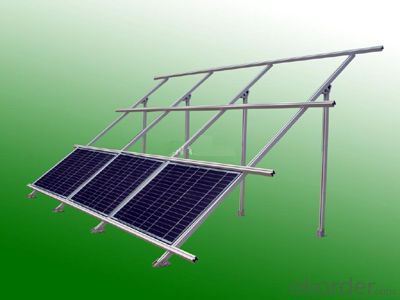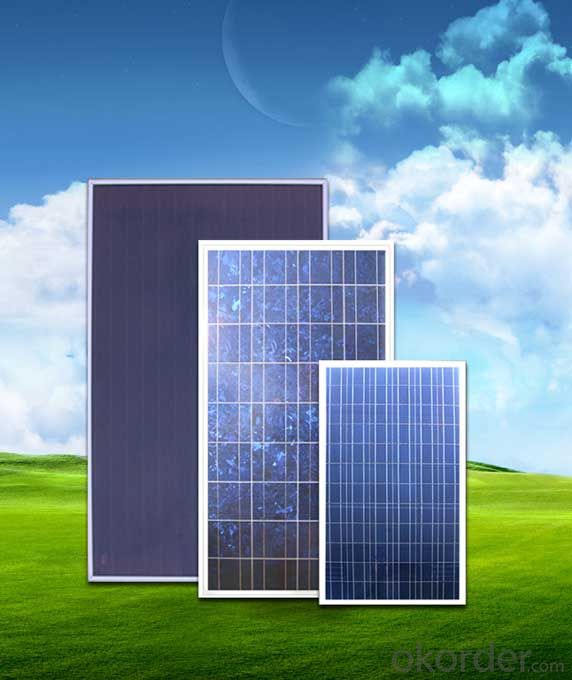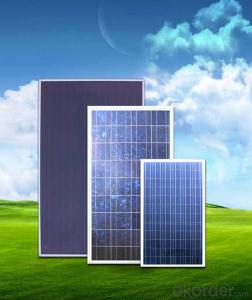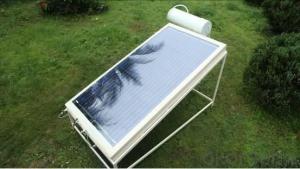Polycrystalline solar Panel with High Quality Best Price CNBM
- Loading Port:
- Qingdao
- Payment Terms:
- TT OR LC
- Min Order Qty:
- 10 set
- Supply Capability:
- 300000 set/month
OKorder Service Pledge
OKorder Financial Service
You Might Also Like
Polycrystalline Solar Modules
CNBM offers a range of small, medium and large polycrystalline solar modules, designed for a range of requirements.


Specifications:
Tolerance | +/-3% |
Cell | Polycrystalline silicon solar cells (156 x 156mm) |
N0. of Cells | 60 (0 x 6) |
Dimension of Modules (mm) | 1650 x 990 x 40 |
Weight (kg) | 25.5 |
Limits:
Operating Temperature | -40~+85? |
Storage Temperature | -40~+85? |
Maximum System Voltage | 1000 VDC max. |
Hail Impact | Diameter of 28mm with impact speed |
Temperature and Coefficients:
NOCT | 48C+/-2? |
Voltage temperature coefficient (%/K) | -0.35 |
Current temperature coefficient (%/K) | 0.05 |
Power temperature coefficient (%/K) | -0.45 |
Characteristics:
Model: | SGM-200P | SGM-210P | SGM-220P |
Max-power voltage Vmp (V) | 29.2 | 29.4 | 29.41 |
Max-power current Imp (A) | 6.85 | 7.14 | 7.48 |
Open-circuit voltage Voc (V) | 36.5 | 36.69 | 36.9 |
Short-Circuit Current Isc (A) | 7.28 | 7.6 | 7.93 |
Max-power Pm(W) | 200 | 210 | 220 |
Model: | SGM-230P |
Max-power voltage Vmp (V) | 29.8 |
Max-power current Imp (A) | 7.72 |
Open-circuit voltage Voc (V) | 37.31 |
Short-Circuit Current Isc (A) | 8.19 |
Max-power Pm(W) | 230 |
STC: Irradiance 1000W/m2, module temperature 25?, AM-=1.5
Poly Crystalline Solar Panels Specifications Range
Maximum Power (Pm) | Dimension | Weight | Operating Voltage (Vmp) | Operating Current (Imp) | Open Circuit Voltage (Voc) | Short Circuit Current (Isc) |
0.45W | 140x80x10mm | 0.08kg | 3.3V | 150mA | 4.6V | 160mA |
1.0W | 162x140x10mm | 0.16kg | 7.5V | 150mA | 10.3V | 160mA |
4.5W | 269x251x23mm | 0.8kg | 16.5V | 0.27A | 20.5V | 0.3A |
10W | 420.1×268.9×22.6mm | 1.92kg | 17.5V | 0.58A | 20.5V | 0.6A |
20W | 425x502x50mm | 3.0kg | 16.8V | 1.19A | 21.0V | 1.29A |
30W | 593x502x22.6mm | 3.9kg | 16.8V | 1.78A | 21.0V | 1.94A |
40W | 655x537x50mm | 5.75kg | 17.3V | 2.31A | 22.1V | 2.54A |
50W | 839x537x50mm | 6.0kg | 17.5V | 2.9A | 21.8V | 3.17A |
65W | 1111x502x50mm | 7.2kg | 17.6V | 3.69A | 22.1V | 3.99A |
80W | 1204x537x50mm | 7.7kg | 17.6V | 4.55A | 22.1V | 4.8A |
- Q:What is the solar cells market in China?
- As far as I know, it's developing very well. Not only in terms of the technology but also in terms of the sales revenues. Many solar cells factories are located there
- Q:How do solar cells perform in areas with high levels of wildfire smoke?
- Solar cells generally perform less efficiently in areas with high levels of wildfire smoke. The smoke particles in the air can reduce the amount of sunlight reaching the solar panels, thereby decreasing their energy production. Additionally, the smoke can settle on the surface of the panels, creating a layer that further hinders the absorption of sunlight. Regular cleaning may be required to maintain optimal performance in such areas.
- Q:Does the solar cell generate electricity in the absence of the sun, only in the case of strong lights or lasers? If you can achieve how much, and the same day?
- One of the directions for the development of modern solar cells is to maximize the frequency range of the light waves that can be energized (to the low frequency direction) to increase the power generation efficiency of solar cells
- Q:Can solar cells be used to power homes?
- Yes, solar cells can be used to power homes. Solar panels, made up of multiple solar cells, can convert sunlight into electricity which can then be used to power various appliances and systems in a household.
- Q:How do solar cells impact national energy policies?
- Solar cells have a significant impact on national energy policies by driving the shift towards renewable energy sources. As solar power becomes more affordable and efficient, governments are incentivized to promote its adoption through various policies and initiatives. This includes providing subsidies and tax incentives to encourage investment in solar energy, setting renewable energy targets, and implementing net metering policies that allow consumers to sell excess electricity back to the grid. The wide-scale deployment of solar cells helps diversify energy sources, reduce dependence on fossil fuels, and mitigate climate change, thereby shaping and influencing national energy policies.
- Q:Can solar cells be used for water heating?
- Yes, solar cells can be used for water heating. Solar thermal systems use solar energy to heat water directly, while solar photovoltaic systems can generate electricity to power water heaters. Both methods are efficient and environmentally friendly alternatives to traditional water heating systems.
- Q:Can solar cells be integrated into building materials?
- Yes, solar cells can be integrated into building materials. Building-integrated photovoltaics (BIPV) is a growing trend where solar cells are embedded into roofing materials, windows, facades, and other building components. This integration allows for the generation of electricity while maintaining the aesthetics and functionality of the building.
- Q:Can solar cells be used in aviation or aerospace applications?
- Yes, solar cells can be used in aviation or aerospace applications. Solar cells are commonly used in satellites to generate electricity from sunlight. They can also be used in unmanned aerial vehicles (UAVs) or drones to power their systems and extend their flight time. Additionally, some experimental aircraft have integrated solar panels to supplement their power needs.
- Q:Why should the solar cells be laserized?
- While the P2, P3 level with green nano-laser is the most ideal. In the actual experiment process using green picosecond laser technology the best, but taking into account the cost of equipment into the point of view, green nanosecond most ideal
- Q:How do solar cells impact energy security?
- Solar cells have a positive impact on energy security as they provide a clean and renewable source of electricity. By reducing dependence on fossil fuels, solar cells contribute to a more sustainable energy mix, decreasing the vulnerability to price fluctuations and supply disruptions associated with traditional energy sources. Additionally, solar cells can be installed at various scales, from individual households to large-scale power plants, enhancing energy diversification and decentralization, thus strengthening overall energy security.
1. Manufacturer Overview |
|
|---|---|
| Location | |
| Year Established | |
| Annual Output Value | |
| Main Markets | |
| Company Certifications | |
2. Manufacturer Certificates |
|
|---|---|
| a) Certification Name | |
| Range | |
| Reference | |
| Validity Period | |
3. Manufacturer Capability |
|
|---|---|
| a)Trade Capacity | |
| Nearest Port | |
| Export Percentage | |
| No.of Employees in Trade Department | |
| Language Spoken: | |
| b)Factory Information | |
| Factory Size: | |
| No. of Production Lines | |
| Contract Manufacturing | |
| Product Price Range | |
Send your message to us
Polycrystalline solar Panel with High Quality Best Price CNBM
- Loading Port:
- Qingdao
- Payment Terms:
- TT OR LC
- Min Order Qty:
- 10 set
- Supply Capability:
- 300000 set/month
OKorder Service Pledge
OKorder Financial Service
Similar products
New products
Hot products
Hot Searches
Related keywords





























